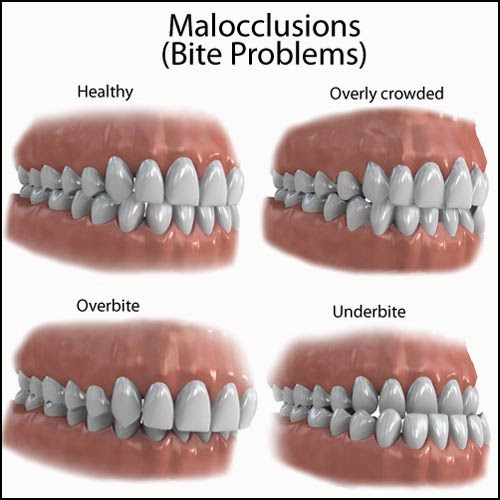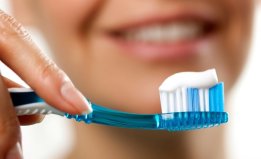What is an uneven bite (malocclusion)?
Occlusion is another way to describe the way your teeth align when your jaw is closed. Thus, malocclusion is when there is a problem with your occlusion and your teeth are misaligned when the jaws are closed. This is more common referred to as an uneven bite.
Types of malocclusion
An ideal occlusion involves the upper teeth being slightly in front of the lower teeth. There are a several different types of malocclusion, but the most common types are described below:
Overbite: When the upper jaw severely overlaps the bottom jaw and teeth. In severe cases, the top front teeth can be contacting the lower gums.
Underbite: When the lower jaw is in front and overlaps the upper jaw.

Signs and symptoms of an uneven bite
An uneven bite can have effects beyond cosmetical. If left untreated, misalignment of the jaw can lead to serious pain and discomfort, as well as increase chances of developing cavities and tooth decay. Below are some common signs and symptoms associated with uneven bites:
Appearance
The most obvious sign of malocclusion is if your teeth are visually crooked. You can easily check this using a mirror to check the alignment of your teeth. Teeth that are misaligned, twisted, overcrowded, or overall crooked may indicate that there may be some degree of malocclusion.
Headache
An uneven bite can result in jaw muscles being chronically tensed or strained which may result in frequent headaches. If you suffer from regular headaches, a misaligned bite may be to blame because the jaw muscles are being strained from the misalignment.
Grinding and/or jaw clenching
Grinding and clenching or mechanisms that the jaw uses to overcompensate for bite misalignment. However, chronic grinding can wear down enamel over time and compromise the overall structure of your teeth.
Jaw pain and/or temporomandibular joint (TMJ) disorder
As mentioned earlier, your jaw will strain the muscles to try to overcompensate for any malalignment. This constant muscular straining can compromise other actions to being painful such as chewing or even talking. TMJ disorder is characterized by clicking and jaw pain that accompanies chewing, yawning or speaking. With malocclusion, the strain on the TMJ is greater and your teeth are misaligned.
Tooth Sensitivity
Briefly, your basic tooth structure is composed of a few layers:
- The enamel - the outermost hard layer
- The dentine – the softer supporting layer
- The pulp – the innermost layers containing nerves and blood vessels
If you are experiencing tooth sensitivity, it could be indicative that your enamel layer is being worn down to the pulpal layer where all the nerves are. An uneven bite may add pressure to specific parts of your teeth instead of distributing it evenly. Enamel would wear away quicker in those pressure points compared to other teeth, and eventually lead to tooth sensitivity. Enamel erosion also increases the chances of developing cavities and experiencing further tooth decay.
Possible Causes
An imbalance between the jaw tendons, muscles, and bone can result in the entire jaw becoming uneven and leading to malocclusion. Below are a several common causes of malocclusion:
- Genetics: Malocclusion is most often genetically inherited.
- Trauma: Any trauma leading to the jaw being fractured, dislocated, or broken can result in future malocclusion Severe injuries may need surgery to help the jaw heal properly in the right location.
- Poor dental work: Improperly performed dental work can cause more damage than good. Certain treatments if done poorly can improperly shift your teeth, cause jaw strain, and result in overall misalignment between the upper and lower teeth.
- Lifestyle influences: Certain life style/childhood habits have been associated with malocclusion including tongue thrusting, thumb sucking, and grinding.
Treatments Options
Most people will have some form of mild malocclusion which do not require any treatment. However, if malocclusion is moderate to severe, orthodontic treatment or surgery may be required. There are a variety of different treatments depending on the severity of the malocclusion.
Orthodontic Treatment
Orthodontic treatment involves using braces (wired or Invisalign), retainers, and other methodologies to slowly move and correct the position of the jaw and teeth over time. Depending on the severity of the malalignment, this may take several months to several years, and can be a costly process. However, the end result of orthodontic treatment is long-lasting with proper maintenance and results in both cosmetic and medical improvements.
Invisalign Braces
Invisalign is a new method of orthodontic treatment that aims to realign your teeth without the use of traditional metal braces. Orthodontic treatment using Invisalign involves getting a series of customized clear plastic retainer-fitting trays for your teeth. Each tray is incrementally closer to the final teeth position, so you will wear each tray for the appropriate amount of time and then shift to the next, eventually shifting your teeth into the proper position. The major complaint many patients have about traditional braces is the cosmetics of the treatment and the discomfort.
Invisalign has multiple advantages and overcomes many of the shortcomings of traditional braces.
Invisalign is significantly more comfortable to wear physically. There are no wires or brackets involved so cuts are avoided. The plastic trays are smooth which are less irritable in the mouth. Trays are also removable which allows for easier cleaning and maintenance of your teeth and trays.
It is important to be able to maintain a proper oral hygiene treatment during your orthodontic treatment otherwise gum disease and cavity development can still occur even on straight teeth! Removable trays also allow patients to eat any foods they want!
Perhaps the biggest advantage of Invisalign is that it is cosmetically more appealing during the treatment course. Because it is clear, the trays are hardly noticeable which many patients enjoy.
Like any long-term orthodontic treatment, Invisalign trays can be uncomfortable in the beginning, especially when getting fitted for a new set. Many patients use pain relievers during the period their teeth are adjusting to the new trays.
In order to have maximum efficiency, Invisalign treatment requires patients to wear them for at least 22 hours everyday for the duration of the treatment. Ideally, they are only removed when eating or brushing/flossing. With that said, the trays must be removed before eating any food which may be inconvenient for many especially if during certain occasions.
Surgery
In more severe cases of malocclusion, correcting the jaw position may require surgery. The type of surgery will depend on what kind of malocclusion you have, and the underlying cause. Below are some examples of surgeries your doctor may choose:
Mandibular osteotomy: This surgery corrects for over- and underbites and involves surgically moving the lower jaw forward or backwards depending on what is needed.
Genioplasty: This surgery corrects for a crooked or small chin and is largely a cosmetical surgery. A sliding genioplasty involves surgically moving the chin into the ideal position. A chin implant would involve reshaping or enlarging the appearance of the chin through implanting a plastic material on the chin, or injecting fillers.
Jaw wiring: This is a medical procedure used to help jaw healing after a severe fracture. Jaw wiring involves installing wires that keep the jaw closed for a period of time in order to fix the jaw in place during the healing process.






